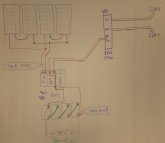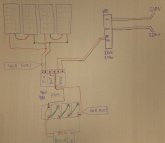WoodsieLord
New Member
Hello, my name is Agustin. I'm from Buenos Aires, Argentina. I'm in the 30-40 y/o range, I work in IT, and I have a thing for solar energy since I asked my father about it when I was a kid.
I've been reading the forum a bit (after watching quite a bunch of Will's clips on youtube) so I think it's time to introduce my idea/Project so I might be able to get help.
I hope you can bear with me:
- I don't speak (write?) english very well. Please ignore my silly mistakes (or even better: Mark them for me ?)
- I live in a 3rd world country with LIMITED access to technology (a renogen 2.4kva 24V MPPT all in one is around 3 standard salaries. Anual Inflation is currently around 53,5%).
- I'm a bit crazy. I live in a 9th floor and I have more plants that I can account for. Now, my solar project is only possible because the roof is just above me (mine is last floor).
- Due to costs and product availability limitations, I might not use standard solutions. This might seems that I complicate things unnecesarily.
A summary of my project, including questions:
1. How the project came to be.
2. What I have. Sizing?.
3. Current parts. With pictures!. Sizing?!
4. Strategy and factibility.
1. I had my first Uninterruptible Power Supply when I was 14. My father bought it second handed. It was a 220v 1kva simple (interactive, not online), worked at 24V so I used it with two cheapo 12V car batteries bought at the super market. The house had two circuits, one for the lower floor and another for the upper one. My room (along with the computers) where in the upper floor. Just a year later, I connected the UPS directly to the circuit (I added an interruptor to be safe). Those nights when the grid went down and I could still play online with my 256kbps ADSL, go to the toilet and the lights kept working... I felt like a demigod of technological sorts.
Fast forward to 2017, and many battery replacements later, that very same UPS died. By that time, I already had experienced at work how superior the online UPS were, and I KNEW I wanted to have one of those. So I got my hands on an Emerson Liebert GXT2-2000VA and realized my gaming setup with the 55 inch display at full throttle showed that the UPS was below 50% capacity. So I got greedy...
2. Since the UPS (2000VA, 1400W. 48V DC voltage) had juice to spare, I started wondering if it could handle my home lights whole. And it did. And still, it never exceeded the 50% load. I'm in awe even now. (Small home, all LED lights).
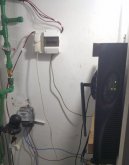
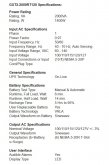
To fulfill this, I moved the UPS to another location, I ran wires to separate some plugs so that my air conditioner, hair dryer, all kitchen appliances and some spare plugs for the vaccum cleaner go stright to the grid. At this point, I was sure I wanted to try solar. From my point of view at that time, I felt that the hard part was already done. It was a matter of how to provide the battery bank with power, other than the mains power supply... from the UPS perspective, it would experience the longest power outage EVER.
(At this point I had already read a lot about solar on the internet, started querying sellers and ended up purchasing the Solar panels. Batteries came later on.)
So, once I had the circuit running stable for some time, I started gathering data from my power consumption. For this, I installed a mains power metter I had lying around and an IP camera that took pics at 1 hour intervals for a few days. I used a spreadsheet to get some averages and graphs for better understanding.
I ran this analysis many times. According to my latest test, this were my daily averages on a 5 days run:
- power consumption was 3,78 Kwh.
- Peak (1 hour interval) was 540wh.
- Average consumption (interval) was 160wh, with 120wh standard deviation.
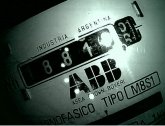
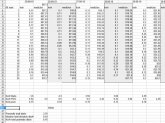
Please note that the power meter is placed at the output of the UPS. This means that the inverter efficiency is ignored. You might also wonder, why my minimum power consumption never goes below 0,1 Kwh. Even when I'm not at home. Okay, the culprits might be my home server, PoE Switch (and external IP camera), a raspberry pi, and a cisco 1941 router (a total overkill for home use, I know, I got it just ...because!).

My objective, at this time, would be to lower my energy bill. This means, I won't hesitate to switch back to the grid if weather won't cooperate. But my goal is to make this circuit independant from the grid.
So, If my daily power consumption is ~3,8kwh/day I need a battery bank that can provide those ~3,8kwh without degrading. The battery chemistries available in my country are: Lead Acid. Done. Or else you can use the same money printer to pay the bill and you save 100% without investing in solar panels.
For those of us who don't have a money printing machine (and thus, have to get up early, have a job and such) the matter is fairly simple: WHICH lead acid battery to get.
Anyway, I'll get into that shortly. For now, lets agree that the battery bank must be Lead acid and I musn't go past 50% discharge (else, it degrades awfully faster, right?) This means my battery bank should be ~3,8kwh x2 = 7,6 kwh.
But, is my consumption ~3,8kwh/day ? Well no, right?. Theory dictates that it shall be greater due to losses (in wiring, the inverter, etc). I don't know my inverters efficiency and I have no way to calculate my own approximation: If I check the UPS AC input, I will be mettering the power supply (which won't be used once I install the panels). I might test it anyway to have a worst case scenario.
3. I tried to get the greatest quality panels and batteries I could afford. So I bought four 24V 340W monocrystaline panels (although they're made in china) and four Alphacell ("gel 165 gxl". Sticker says "AGM") 12V 110A (made in the united States). Even with extreme lousy calculations, I already know I'm (at least) two panels and 50Ah storage short.
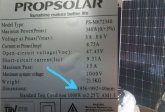

I wanted to get an MPPT charge controller but they were extremely expensive, so I went with a PWM. It will have to do for now. The charge controller model is "KT4840" and as you may infer it is rated at 48V and 40A.
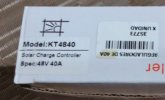

So..., time to show You my maths.
I live in Buenos Aires and according to an argentinian well trusted solar chart (Grossi-Gallegos): per horizontal square meter we get between 6,5 Kwh/day (summer, sun is in a ~14º inclination) and 2 Kwh/day (winter, sun is in a ~54º inclination). Panels must face north, and if aligned at 54º against the horizon 3,6 Kwh/day can be squeezed in winter. Since I haven't done any mounting yet, and my conditions are rather ...unsafe/adverse (10th floor, no railings, leightwight/mild winds) I'm not sure if I will be using the recommended inclination.
A. Winter without inclination:
Since my Panels are rated at 340W (when sun hits a square meter with 1000W), and the chart says that I will be getting 2000W per square meter, the best I could expect would be 340W x2 from each of the four panels. So, 340W x2 x4 =~ 2720Wh per sunny day. (At 48V those mean 56A, right?). So 2720Wh per day is way less than what I'm currently using. Yikes! Going backwards, if I require 3,8kwh per day, while using 340W panels in winter => [3800wh/(340wh · 2)]= 5,58 panels (hence, six panels). But this last number is missing all the losses ahead.
B. Winter with inclination:
instead of getting 2000W per square meter, I would get 3600W. So...
340W x3,6 x4 =~ 4896W per day. The difference seems to be really worth it. If this is correct, my four panels MIGHT be able to handle my current calculated consumption if the losses are not greater.
C. Best case scenario, at summer:
340W x6,5 x4 =~ 8840W. Very nice indeed. I have plans to harness this excess power. But that's for another topic.
Recap:
A. Winter, no inclination. Panels produce ~2700Wh per day.
B. Winter, 54º inclination. Panels produce ~4850Wh per day.
C. Summer, no inclination. Panels produce ~8800Wh per day.
According to wills video about losses calculation:
- using proper wiring I should be safe to assume ~2% loss per wiring segment.
- ~30% loss due to Pulse wide modulation technology.
- ~5% loss due to Lead Acid technology in case my batteries are GOOD.. 20% if they're not (I hope I have chosen wisely)
- ~10% loss assuming my Emerson UPS features a top quality inverter (I might be biased. I've seen greater efficiency in bigger models but I could not find the exact one on mine). So, all in all, my efficiency will be ranging from 48% to 57%. ( 1 * 0.98 * 0.7 * 0.98 * 0.8 * 0.9 ) and ( 1 * 0.98 * 0.7 * 0.98 * 0.95 * 0.9 ) respectively. Right? I hope my batteries are decent.
A. 2700Wh ~> 1540Wh. Too short. Useless I think.
B. 4850Wh ~> 2760Wh. Maybe use solar during day and switch to grid on afternoons?
C. 8800Wh ~> 5010Wh. This seems it would actually work.
Are my calculations more or less accurate? Any fatal flaws or mistakes I should know of?
If I switch my math around, I know I require ~ 3.8Kwh per day. Lets say 4Kwh. So my panels should produce 4Kwh/0.57 ~> 7Kwh now "featuring" losses.
So..
A' (winter, no inclination): 7Kwh/(340W * 2) => 10.29 ~ 11 ELEVEN panels. They won't even fit in my roof.
B' 7Kwh/(340W * 3.6) => 5.71 ~ 6 SIX panels. I'm willing to add two more. They would fit.
C' 7Kwh/(340W * 6.5) => 3.16 ~ 4 FOUR panels. Yeey! I already have those four.
Part 1/2 ( I hit the 10.000 max characters limit. Ooops..)
I've been reading the forum a bit (after watching quite a bunch of Will's clips on youtube) so I think it's time to introduce my idea/Project so I might be able to get help.
I hope you can bear with me:
- I don't speak (write?) english very well. Please ignore my silly mistakes (or even better: Mark them for me ?)
- I live in a 3rd world country with LIMITED access to technology (a renogen 2.4kva 24V MPPT all in one is around 3 standard salaries. Anual Inflation is currently around 53,5%).
- I'm a bit crazy. I live in a 9th floor and I have more plants that I can account for. Now, my solar project is only possible because the roof is just above me (mine is last floor).
- Due to costs and product availability limitations, I might not use standard solutions. This might seems that I complicate things unnecesarily.
A summary of my project, including questions:
1. How the project came to be.
2. What I have. Sizing?.
3. Current parts. With pictures!. Sizing?!
4. Strategy and factibility.
1. I had my first Uninterruptible Power Supply when I was 14. My father bought it second handed. It was a 220v 1kva simple (interactive, not online), worked at 24V so I used it with two cheapo 12V car batteries bought at the super market. The house had two circuits, one for the lower floor and another for the upper one. My room (along with the computers) where in the upper floor. Just a year later, I connected the UPS directly to the circuit (I added an interruptor to be safe). Those nights when the grid went down and I could still play online with my 256kbps ADSL, go to the toilet and the lights kept working... I felt like a demigod of technological sorts.
Fast forward to 2017, and many battery replacements later, that very same UPS died. By that time, I already had experienced at work how superior the online UPS were, and I KNEW I wanted to have one of those. So I got my hands on an Emerson Liebert GXT2-2000VA and realized my gaming setup with the 55 inch display at full throttle showed that the UPS was below 50% capacity. So I got greedy...
2. Since the UPS (2000VA, 1400W. 48V DC voltage) had juice to spare, I started wondering if it could handle my home lights whole. And it did. And still, it never exceeded the 50% load. I'm in awe even now. (Small home, all LED lights).


To fulfill this, I moved the UPS to another location, I ran wires to separate some plugs so that my air conditioner, hair dryer, all kitchen appliances and some spare plugs for the vaccum cleaner go stright to the grid. At this point, I was sure I wanted to try solar. From my point of view at that time, I felt that the hard part was already done. It was a matter of how to provide the battery bank with power, other than the mains power supply... from the UPS perspective, it would experience the longest power outage EVER.
(At this point I had already read a lot about solar on the internet, started querying sellers and ended up purchasing the Solar panels. Batteries came later on.)
So, once I had the circuit running stable for some time, I started gathering data from my power consumption. For this, I installed a mains power metter I had lying around and an IP camera that took pics at 1 hour intervals for a few days. I used a spreadsheet to get some averages and graphs for better understanding.
I ran this analysis many times. According to my latest test, this were my daily averages on a 5 days run:
- power consumption was 3,78 Kwh.
- Peak (1 hour interval) was 540wh.
- Average consumption (interval) was 160wh, with 120wh standard deviation.


Please note that the power meter is placed at the output of the UPS. This means that the inverter efficiency is ignored. You might also wonder, why my minimum power consumption never goes below 0,1 Kwh. Even when I'm not at home. Okay, the culprits might be my home server, PoE Switch (and external IP camera), a raspberry pi, and a cisco 1941 router (a total overkill for home use, I know, I got it just ...because!).

My objective, at this time, would be to lower my energy bill. This means, I won't hesitate to switch back to the grid if weather won't cooperate. But my goal is to make this circuit independant from the grid.
So, If my daily power consumption is ~3,8kwh/day I need a battery bank that can provide those ~3,8kwh without degrading. The battery chemistries available in my country are: Lead Acid. Done. Or else you can use the same money printer to pay the bill and you save 100% without investing in solar panels.
For those of us who don't have a money printing machine (and thus, have to get up early, have a job and such) the matter is fairly simple: WHICH lead acid battery to get.
Anyway, I'll get into that shortly. For now, lets agree that the battery bank must be Lead acid and I musn't go past 50% discharge (else, it degrades awfully faster, right?) This means my battery bank should be ~3,8kwh x2 = 7,6 kwh.
But, is my consumption ~3,8kwh/day ? Well no, right?. Theory dictates that it shall be greater due to losses (in wiring, the inverter, etc). I don't know my inverters efficiency and I have no way to calculate my own approximation: If I check the UPS AC input, I will be mettering the power supply (which won't be used once I install the panels). I might test it anyway to have a worst case scenario.
3. I tried to get the greatest quality panels and batteries I could afford. So I bought four 24V 340W monocrystaline panels (although they're made in china) and four Alphacell ("gel 165 gxl". Sticker says "AGM") 12V 110A (made in the united States). Even with extreme lousy calculations, I already know I'm (at least) two panels and 50Ah storage short.


I wanted to get an MPPT charge controller but they were extremely expensive, so I went with a PWM. It will have to do for now. The charge controller model is "KT4840" and as you may infer it is rated at 48V and 40A.


So..., time to show You my maths.
I live in Buenos Aires and according to an argentinian well trusted solar chart (Grossi-Gallegos): per horizontal square meter we get between 6,5 Kwh/day (summer, sun is in a ~14º inclination) and 2 Kwh/day (winter, sun is in a ~54º inclination). Panels must face north, and if aligned at 54º against the horizon 3,6 Kwh/day can be squeezed in winter. Since I haven't done any mounting yet, and my conditions are rather ...unsafe/adverse (10th floor, no railings, leightwight/mild winds) I'm not sure if I will be using the recommended inclination.
A. Winter without inclination:
Since my Panels are rated at 340W (when sun hits a square meter with 1000W), and the chart says that I will be getting 2000W per square meter, the best I could expect would be 340W x2 from each of the four panels. So, 340W x2 x4 =~ 2720Wh per sunny day. (At 48V those mean 56A, right?). So 2720Wh per day is way less than what I'm currently using. Yikes! Going backwards, if I require 3,8kwh per day, while using 340W panels in winter => [3800wh/(340wh · 2)]= 5,58 panels (hence, six panels). But this last number is missing all the losses ahead.
B. Winter with inclination:
instead of getting 2000W per square meter, I would get 3600W. So...
340W x3,6 x4 =~ 4896W per day. The difference seems to be really worth it. If this is correct, my four panels MIGHT be able to handle my current calculated consumption if the losses are not greater.
C. Best case scenario, at summer:
340W x6,5 x4 =~ 8840W. Very nice indeed. I have plans to harness this excess power. But that's for another topic.
Recap:
A. Winter, no inclination. Panels produce ~2700Wh per day.
B. Winter, 54º inclination. Panels produce ~4850Wh per day.
C. Summer, no inclination. Panels produce ~8800Wh per day.
According to wills video about losses calculation:
- using proper wiring I should be safe to assume ~2% loss per wiring segment.
- ~30% loss due to Pulse wide modulation technology.
- ~5% loss due to Lead Acid technology in case my batteries are GOOD.. 20% if they're not (I hope I have chosen wisely)
- ~10% loss assuming my Emerson UPS features a top quality inverter (I might be biased. I've seen greater efficiency in bigger models but I could not find the exact one on mine). So, all in all, my efficiency will be ranging from 48% to 57%. ( 1 * 0.98 * 0.7 * 0.98 * 0.8 * 0.9 ) and ( 1 * 0.98 * 0.7 * 0.98 * 0.95 * 0.9 ) respectively. Right? I hope my batteries are decent.
A. 2700Wh ~> 1540Wh. Too short. Useless I think.
B. 4850Wh ~> 2760Wh. Maybe use solar during day and switch to grid on afternoons?
C. 8800Wh ~> 5010Wh. This seems it would actually work.
Are my calculations more or less accurate? Any fatal flaws or mistakes I should know of?
If I switch my math around, I know I require ~ 3.8Kwh per day. Lets say 4Kwh. So my panels should produce 4Kwh/0.57 ~> 7Kwh now "featuring" losses.
So..
A' (winter, no inclination): 7Kwh/(340W * 2) => 10.29 ~ 11 ELEVEN panels. They won't even fit in my roof.
B' 7Kwh/(340W * 3.6) => 5.71 ~ 6 SIX panels. I'm willing to add two more. They would fit.
C' 7Kwh/(340W * 6.5) => 3.16 ~ 4 FOUR panels. Yeey! I already have those four.
Part 1/2 ( I hit the 10.000 max characters limit. Ooops..)



